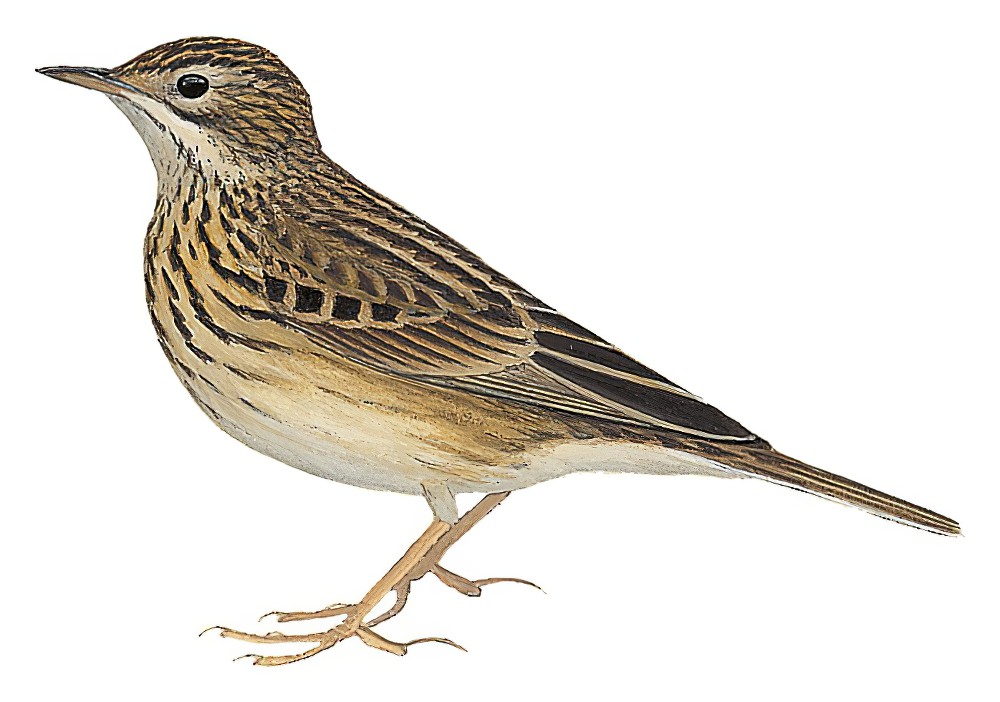Short-billed Pipit / Anthus furcatus

Short-billed Pipit
SCI Name:
Protonym: Anthus furcatus Mag.Zool. 7 cl.2 p.27
Taxonomy: Passeriformes / Motacillidae / Anthus
Taxonomy Code: shbpip1
Type Locality: Patagonia = Carmen, Rio Negro, fide Hellmayr.
Author: d''Orbigny & Lafresnaye
Publish Year: 1837
IUCN Status: Least Concern
DEFINITIONS
ANTHUS
(Motacillidae; † Meadow Pipit A. pratensis) L. anthus small bird that inhabited grasslands mentioned by Pliny, not further identified, but probably the Yellow Wagtail < Gr. ανθος anthos small, brightly coloured bird mentioned by Aristotle. In Gr. myth. Anthus, son of Antinous and Hippodamia, was killed by his father’s horses and metamorphosed into a bird which imitated the neighing of horses but fled at their sight; "47. Pieper. Anthus. Ich rechne zu dieser neuen Gattung vier Arten. ... Das was Frisch in der Naturgeschichte von No. III. von der Greuthlerche erzählt, gehört eigentlich zur Pieplerche (Alauda trivialis), die er Wiesenlerche nennt. Das aber, was er von der Wiesenlerche No. IV. sagt, paßt nur auf die Brachlerche (Alauda campestris). Das, was er von felner Pieplerche sagt, hat zwar seine Richtigkeit, allein die Ueberschrift ist falsch, und sollte eigentlich Wiesenlerche (Alauda pratensis) heißen *). ... *) Diese Vögel, nämlich die Brach- Piep- und Wiesenlerche haben zu vielen Irrthümern in den naturhistorischen Schriften Anlaß gegeben. Ich habe mich selbst irre führen lassen. Ich habe daher für dieselben, da sie zu auffallend von den Lerchen abweichen, eine besondere Gattung, die ich Anthus nenne, gebildet. ... 161. Die Brachlerche oder der Brachpieper. Alauda campestris. L. Taf. 15. Fig. 2. b. (Anthus campestris, mihi." (Bechstein 1805); "Anthus Bechstein, Gemein. Naturg. Deutschl. ii, pp. 247, 302, 1805. Type by subsequent designation of Mathews (Austral Av. Rec. ii, p. 123, 1918), Alauda campestris. ... This genus until recently has been quoted from Bechstein's third volume, p. 704, 1807, and the type designated by Gray in 1840 as A. spinoletta. Under the earlier citation of Anthus, here quoted, the Water-Pipit is not mentioned, so that it cannot under the Rules be designated as the type of the genus. The three species which are mentioned by Bechstein are A. campestris, A. trivialis, and A. pratensis. Sharpe, in Cat. Bds. Brit. Mus. x, p. 534, 1885, designated A. trivialis, but did not quote the earlier reference to Bechstein. Mathews subsequently therefore (Austral Av. Rec. ii, p. 123, 1918) designated A. campestris, which is here accepted as the type." (W. Sclater, 1930, Syst. Av. Aethiop., II, 340); "Anthus Bechstein, 1805, Gemein. Nat. Deutschl., 2, p. 247, 302, 465. Type, by subsequent designation, Alauda pratensis Linnaeus (Selby, 1825, Illust. Brit. Orn., p. xxix)." (Vaurie in Peters, 1960, IX, p. 144).
Var. Arthur, Artthus.
Synon. Afranthus, Agrodroma, Anomalanthana, Anomalanthus, Austranthus, Caffranthus, Cichlops, Cinaedium, Corydalla, Dendronanthus, Heterura, Leimoniptera, Meganthus, Megistina, Neocorys, Notiocorys, Oreocorys, Pediocorys, Petranthus, Pipastes, Rhabdochlamys, Seiren, Spipola, Xanthocorys.
furcatum / furcatus
Med. L. furcatus forked < L. furca two-pronged fork < ferre to tend.
● ex “Mouette à queue fourchue” of Néboux, 1840 (Creagrus).
● ex “Icterus cauda bifida” of Brisson 1760, and “Fork-tailed Oriole” of Latham 1782 (?Dicrurus sp.).
● ex “Swallow-tail’d Hawk” of Catesby 1731 (syn. Elanoides forficatus).
● ex “Fork-tail Petrel” of Pennant 1785, and Latham 1785 (Hydrobates).
SUBSPECIES
Short-billed Pipit (Puna)
SCI Name: Anthus furcatus brevirostris
brevirostre / brevirostris
Mod. L. brevirostris having a short beak < L. brevis short; -rostris -billed < rostrum beak.
Short-billed Pipit (Fork-tailed)
SCI Name: Anthus furcatus furcatus
furcatum / furcatus
Med. L. furcatus forked < L. furca two-pronged fork < ferre to tend.
● ex “Mouette à queue fourchue” of Néboux, 1840 (Creagrus).
● ex “Icterus cauda bifida” of Brisson 1760, and “Fork-tailed Oriole” of Latham 1782 (?Dicrurus sp.).
● ex “Swallow-tail’d Hawk” of Catesby 1731 (syn. Elanoides forficatus).
● ex “Fork-tail Petrel” of Pennant 1785, and Latham 1785 (Hydrobates).
UPPERCASE: current genus
Uppercase first letter: generic synonym
● and ● See: generic homonyms
lowercase: species and subspecies
●: early names, variants, mispellings
‡: extinct
†: type species
Gr.: ancient Greek
L.: Latin
<: derived from
syn: synonym of
/: separates historical and modern geographic names
ex: based on
TL: type locality
OD: original diagnosis (genus) or original description (species)












